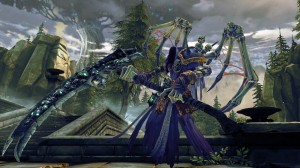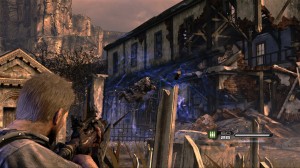 Darksiders was often referred to as one of the most derivative games available, and that sentiment was true up until this week. Yesterday marked the European release of Darksiders II, a game that is itself derived from a very derivative game, and constructed entirely from found parts like some software Frankenstein’s monster.
Darksiders was often referred to as one of the most derivative games available, and that sentiment was true up until this week. Yesterday marked the European release of Darksiders II, a game that is itself derived from a very derivative game, and constructed entirely from found parts like some software Frankenstein’s monster.
This isn’t not news, of course – Darksiders provided most of the ammunition. A game in which you played an avatar of War sounded a lot like God of War, and Darksiders played pretty similarly, too, as it happens. There were dungeons and puzzles and grappling hooks, ripped straight from Zelda. There was even a Portal gun, too, although use of it was fairly limited. Aside from the visual style of the game – a clusterfuck of armour and weapons bolted onto everything that moves – there was very little to be seen that came anywhere near original.
Darksiders II builds on those unoriginal roots, and much of the construction material has been casually stolen from the building sites of other games whilst the foreman was looking the other way. Death controls even more like Kratos than his brother did, and his paired scythes are more reminiscent of the Spartan’s chained blades. A wide-open map peppered with dungeons to wander into and get killed remind me of Bethesda’s standard style, although it lacks any of their ingrained, contagious wanderlust. The random loot system, an inspired addition, has been a core part of Diablo and Borderlands both. The first big boss, an evil stone robot, plays like a sawn-off behemoth from Shadow of the Colossus.
The one original bit that comes to mind is the ability to turn yourself into both a giant stone statue and two identical copies of yourself at the same time, which at the very least I haven’t seen before. Even if it is needlessly complicated and opens up the door to more and more ridiculously convoluted puzzles, apparently designed by temple architects with a keen eye for Death’s levelling progress.
 But for all this, Darksiders II is not a bad game. Mechanically, it is tremendously solid – as stolen as the building blocks might be, they’re sturdy enough to work.
But for all this, Darksiders II is not a bad game. Mechanically, it is tremendously solid – as stolen as the building blocks might be, they’re sturdy enough to work.
The puzzles are well-constructed, and even though I’m heaving giant statues and rotating big levers to open frankly impractical doors it feels good to solve them by applying by limited toolbox in a variety of ingenious ways. The combat, a cracking mix of well-timed combos and furious button-mashing, is a valid test of my abilities and genuinely enjoyable.
It’s not a surefire route to success, of course – second-hand shops are littered with forgotten spy-themed PS2 franchises built on the coat-tails of Splinter Cell. Cover-based shooters, often with bullet-time abilities, are ten a penny and quality tends to be fairly low – the final two Harry Potter games, played straight as a pair of crushingly basic third-person action titles, are a prime example. The games were derided as “Gears of HogWarts” for a reason.
Inversion, a shooter that stole everything it had to offer, was redundant nonsense and a waste of everyone’s time. Zero-gravity sections ripped from Dead Space 2, item-grabbing nicked off Half Life 2’s gravity gun, gravity grappling hooks stolen from – well – any game with a grappling hook in, and the ability to rip enemies out of cover and leave them kicking about uselessly in the air from every single Mass Effect. Even the bits where you fight on the side of a building have brass-heavy echoes from Inception. As does the name, come to think of it.
 Inversion is the title to hold up, here, as a mirror to Darksiders. Where Darksiders has treated the appropriated elements with respect and used them to build a strong game, Inversion has only scratched the surface of what they can do. Darksiders, for example, offers (in addition to the excellent gameplay) an achievement alongside discovery of their portal gun-analogue titled “Can I Has Cake?” It’s not subtle, by any means, but they’re not trying to hide what they’re doing.
Inversion is the title to hold up, here, as a mirror to Darksiders. Where Darksiders has treated the appropriated elements with respect and used them to build a strong game, Inversion has only scratched the surface of what they can do. Darksiders, for example, offers (in addition to the excellent gameplay) an achievement alongside discovery of their portal gun-analogue titled “Can I Has Cake?” It’s not subtle, by any means, but they’re not trying to hide what they’re doing.
Nor, crucially, are they using it as a hook to draw in sales. Much of the promotional material surrounding Darksiders II is about how much of an almighty badass Death is, not how he’s got a grab-bag of toys that you’ve played with before. They’re taking stuff we already like and making it better by putting a grim-looking mask on it. They’re drawing on the history of games and using popular bits of it extremely wisely to make their game better.
Being derivative doesn’t mean being bad. But it does mean the devs have to be as smart as those who innovate, if not more so, to make sure that there’s a good game to show for it.
This isn’t not news, of course – Darksiders provided most of the ammunition. A game in which you played an avatar of War sounded a lot like God of War, and Darksiders played pretty similarly, too, as it happens. There were dungeons and puzzles and grappling hooks, ripped straight from Zelda. There was even a Portal gun, too, although use of it was fairly limited. Aside from the visual style of the game – a clusterfuck of armour and weapons bolted onto everything that moves – there was very little to be seen that came anywhere near original.
Darksiders II builds on those unoriginal roots, and much of the construction material has been casually stolen from the building sites of other games whilst the foreman was looking the other way. Death controls even more like Kratos than his brother did, and his paired scythes are more reminiscent of the Spartan’s chained blades. A wide-open map peppered with dungeons to wander into and get killed remind me of Bethesda’s standard style, although it lacks any of their ingrained, contagious wanderlust. The random loot system, an inspired addition, has been a core part of Diablo and Borderlands both. The first big boss, an evil stone robot, plays like a sawn-off behemoth from Shadow of the Colossus.
The one original bit that comes to mind is the ability to turn yourself into both a giant stone statue and two identical copies of yourself at the same time, which at the very least I haven’t seen before. Even if it is needlessly complicated and opens up the door to more and more ridiculously convoluted puzzles, apparently designed by temple architects with a keen eye for Death’s levelling progress.
The puzzles are well-constructed, and even though I’m heaving giant statues and rotating big levers to open frankly impractical doors it feels good to solve them by applying by limited toolbox in a variety of ingenious ways. The combat, a cracking mix of well-timed combos and furious button-mashing, is a valid test of my abilities and genuinely enjoyable.
It’s not a surefire route to success, of course – second-hand shops are littered with forgotten spy-themed PS2 franchises built on the coat-tails of Splinter Cell. Cover-based shooters, often with bullet-time abilities, are ten a penny and quality tends to be fairly low – the final two Harry Potter games, played straight as a pair of crushingly basic third-person action titles, are a prime example. The games were derided as “Gears of HogWarts” for a reason.
Inversion, a shooter that stole everything it had to offer, was redundant nonsense and a waste of everyone’s time. Zero-gravity sections ripped from Dead Space 2, item-grabbing nicked off Half Life 2’s gravity gun, gravity grappling hooks stolen from – well – any game with a grappling hook in, and the ability to rip enemies out of cover and leave them kicking about uselessly in the air from every single Mass Effect. Even the bits where you fight on the side of a building have brass-heavy echoes from Inception. As does the name, come to think of it.
Nor, crucially, are they using it as a hook to draw in sales. Much of the promotional material surrounding Darksiders II is about how much of an almighty badass Death is, not how he’s got a grab-bag of toys that you’ve played with before. They’re taking stuff we already like and making it better by putting a grim-looking mask on it. They’re drawing on the history of games and using popular bits of it extremely wisely to make their game better.
Being derivative doesn’t mean being bad. But it does mean the devs have to be as smart as those who innovate, if not more so, to make sure that there’s a good game to show for it.
Share this: